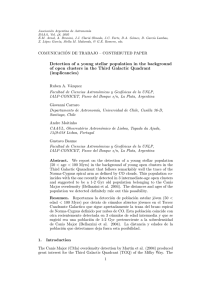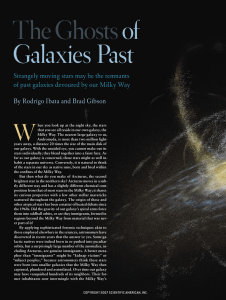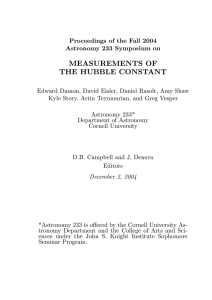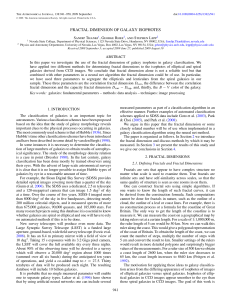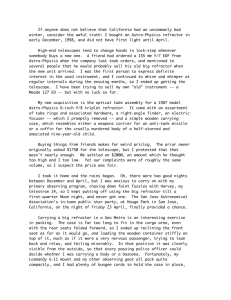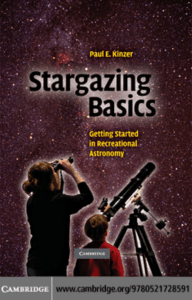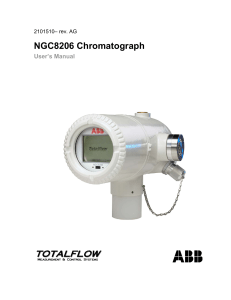Observing Faint Nearby Galaxies Jay Reynolds Freeman Nearby
Anuncio
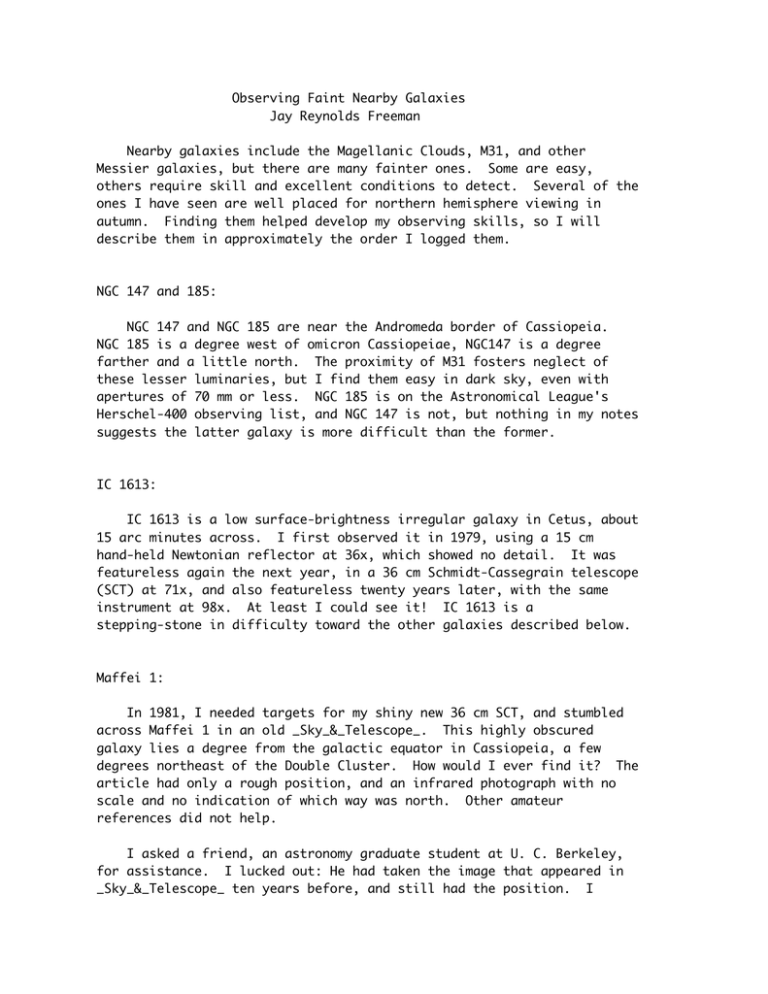
Observing Faint Nearby Galaxies Jay Reynolds Freeman Nearby galaxies include the Magellanic Clouds, M31, and other Messier galaxies, but there are many fainter ones. Some are easy, others require skill and excellent conditions to detect. Several of the ones I have seen are well placed for northern hemisphere viewing in autumn. Finding them helped develop my observing skills, so I will describe them in approximately the order I logged them. NGC 147 and 185: NGC 147 and NGC 185 are near the Andromeda border of Cassiopeia. NGC 185 is a degree west of omicron Cassiopeiae, NGC147 is a degree farther and a little north. The proximity of M31 fosters neglect of these lesser luminaries, but I find them easy in dark sky, even with apertures of 70 mm or less. NGC 185 is on the Astronomical League's Herschel-400 observing list, and NGC 147 is not, but nothing in my notes suggests the latter galaxy is more difficult than the former. IC 1613: IC 1613 is a low surface-brightness irregular galaxy in Cetus, about 15 arc minutes across. I first observed it in 1979, using a 15 cm hand-held Newtonian reflector at 36x, which showed no detail. It was featureless again the next year, in a 36 cm Schmidt-Cassegrain telescope (SCT) at 71x, and also featureless twenty years later, with the same instrument at 98x. At least I could see it! IC 1613 is a stepping-stone in difficulty toward the other galaxies described below. Maffei 1: In 1981, I needed targets for my shiny new 36 cm SCT, and stumbled across Maffei 1 in an old _Sky_&_Telescope_. This highly obscured galaxy lies a degree from the galactic equator in Cassiopeia, a few degrees northeast of the Double Cluster. How would I ever find it? The article had only a rough position, and an infrared photograph with no scale and no indication of which way was north. Other amateur references did not help. I asked a friend, an astronomy graduate student at U. C. Berkeley, for assistance. I lucked out: He had taken the image that appeared in _Sky_&_Telescope_ ten years before, and still had the position. I plotted it on my best charts. On the night of February 2, 1981, Fremont Peak, near Salinas, California, was dark enough to see evening zodiacal light. I examined the location of Maffei 1 at 71x, 121x, and 196x. It felt strange, hunting a faint galaxy in rich star fields, but I spotted a patch of haze a few arc-minutes across, with perhaps ten stars superimposed. I remember thinking that it did not look quite like a partly resolved cluster, though I could not say why. Modern images show that the group of stars has larger angular size than the galaxy's haze, and is not concentric with it. That would be an unusual configuration for a cluster. Maffei 1 was my first really challenging deep-sky object, and I was pleased to log it. The Sculptor Dwarf: In the early 1980s, I repeatedly sought the Sculptor dwarf galaxy with fairly large apertures, failed to find it, and quit: I had learned where it ought to be, and did not trust myself to avoid wishful thinking about seeing it. Then on September 23, 1989, low fog dimmed towns and cities near Fremont Peak. A friend and I decided to try the Sculptor dwarf again, with his 130 mm f/6 triplet refractor. I had forgotten the details of the field, and carefully kept my large-scale charts closed. I used only a rough position, penciled on my old Norton's _Star_Atlas_, four degrees south of alpha Sculptor. We used a 55 mm eyepiece, for 14x. The oversized 9 mm exit pupil wasted light, but gave images of extended objects that were as bright as possible. There was nothing four degrees south of alpha Sculptor that I could call an object, but slowly I noticed that averted vision showed an area half a degree or a degree wide, where the background sky glow was just slightly brighter than elsewhere. It was easier to see when I moved the telescope back and forth rapidly. I centered the apparition and asked my companion to look. He saw it, too. More magnification was no help. glow. With a 32 mm eyepiece, I saw no I tried my 10x70 binocular. To eliminate stray light, I pulled my jacket up over my head, till just the binocular barrels protruded. I looked like a cross between the headless horseman and a battleship gun turret, but there was the glow. Noting its position with respect to nearby stars, I opened my big charts. It lay right on the plotted galaxy! The observation was confirmed. I had probably seen it before. Using an 8-inch Newtonian at 31x, I had noticed variations in background sky glow in that area, but had not realized they might have been the object I was seeking. I have since had better luck with large apertures and small fields, by sweeping slowly and noting changes in sky glow intensity. When I showed the Sculptor dwarf to another friend this way, he said it looked like vignetting -- non-uniform field illumination because of obstructions in the light path -- except that it stayed put when the telescope moved. The Fornax Dwarf, and its Globulars: The Fornax dwarf galaxy is smaller than the Sculptor system, but perhaps slightly easier to see, using the same viewing techniques. It has several globular clusters, including one, NGC 1049, that many amateurs have seen. I logged it with my Celestron 14, years before I detected the rest of the galaxy. NGC 1049 looked like an ordinary globular, with no hint of resolution. _Millennium_Star_Atlas_ plots four more like it, Fornax 1, 2, 4, and 5. I viewed them all recently with my 36 cm SCT at 244x. Fornax 2 was most difficult, and NGC 1049 easiest. Andromeda I, II and III: M31 has some dwarf galaxy companions much like the Sculptor and Fornax systems. Greater distance makes them smaller and fainter, but they fit comfortably in a low-magnification view of a medium to large amateur telescope, which makes them more easily seen as a whole, not merely as a change in background intensity as the telescope moves. Also, from observing sites in northern latitudes, these objects rise far higher than the Sculptor and Fornax galaxies. I find them all demanding but straightforward to view with my 36 cm SCT at 98x, when they are well placed and the sky is dark and clear. I have seen them with slightly smaller apertures as well. Faint nearby galaxies provide an interesting observing program that will improve your deep-sky skills and give you experience with objects that few amateurs have seen. There are lots more besides these, and in other parts of the sky, as well. Good luck finding them!
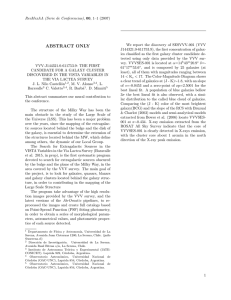
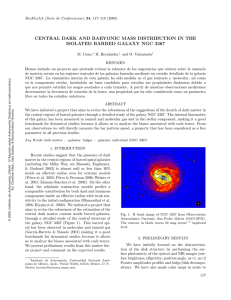

![−10 0 10 20 Dec[arcsec] −10 0 10 20 Dec[arcsec] 1993R 2014cy](http://s2.studylib.es/store/data/006588599_1-c53d6943a09ad7d4952a441ade3bcf51-300x300.png)
